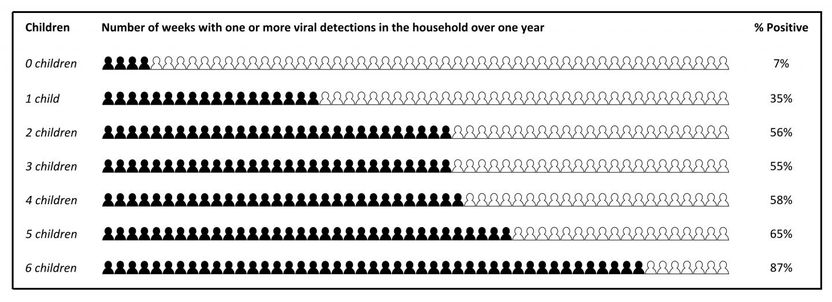Viruses thrive in big families, in sickness and in health
Advertisement
The BIG LoVE (Utah Better Identification of Germs-Longitudinal Viral Epidemiology) study, led by scientists at the University of Utah School of medicine, finds that each bundle of joy puts the entire household at increased risk for infection with viruses that cause colds, flu, and other respiratory illnesses.

The BIG-LoVE (Utah Better Identification of Germs-Longitudinal Viral Epidemiology) study by investigators at the University of Utah School of Medicine shows that every child increases the risk that a household will be infected with respiratory virus. At one extreme, childless households are only sick for 7 percent of the year (3-4 weeks). By contrast, families with 6 children are sick for 87 percent of the year (45 weeks).
University of Utah School of Medicine
People living in childless households were infected with viruses on average 3-4 weeks during the year. In households with one child, that number jumped to 18 weeks, and for those with six children, there was virus in the household for up to 45 weeks out of the year.
Yet on average only half of those who tested positive for viral infection also had the typical symptoms of coughing, fever, and stuffy nose, an informative finding for both families and their health care providers.
Kids Fill Hearts With Love, And Homes With Illness
When it comes to explaining why big families have more illnesses, all signs point to young kids as the culprits. Tots younger than five had at least one virus detected in their nasal mucus for 50 percent of the year: twice as often as older children and adults. And when infected, they were 1.5 times more likely to have symptoms, including severe ones like wheezing and fever.
Adding even more stress to a household, young kids didn't suffer alone. Their parents were sick 1.5 times more frequently than similarly aged adults who did not live with young kids.
It's no secret that children get sick a lot. But BIG LoVE is one of the first to use modern diagnostics to track how often kids and other family members, both sick and well, have nasal infections of respiratory virus.
A Positive Test May Not Mean Positively Sick
Perhaps the most surprising finding was how often participants carried virus, and showed no signs of being sick.
PCR-based diagnostics, like those used to test participants' samples in this study, are becoming increasingly common in clinical settings because they are much more sensitive and accurate than older tests, and provide results within hours, not days. Yet these findings suggest that some test results should be interpreted with caution.
While study participants infected with influenza and parainfluenza viruses were sick most of the time, those who carried rhinovirus - the cause of the common cold - were only sick half of the time.
What's more, results suggest that even after a patient recovers from an illness, some viruses persist for weeks afterward. Bocavirus persisted in the nose for as long as 12 weeks, but more commonly viruses persisted for two weeks or less.
If presence of virus doesn't always translate into illness, then it stands to reason that even if someone is sick and tests positive for a specific virus, there could be another cause. For example bacteria, or a rare virus not detected by the test. Health care providers should be aware of these limitations.
Original publication
C. L. Byington et al., "Community Surveillance of Respiratory Viruses Among Families in the Utah Better Identification of Germs-Longitudinal Viral Epidemiology (BIG-LoVE) Study", Clinical Infectious Diseases, 2015

























































